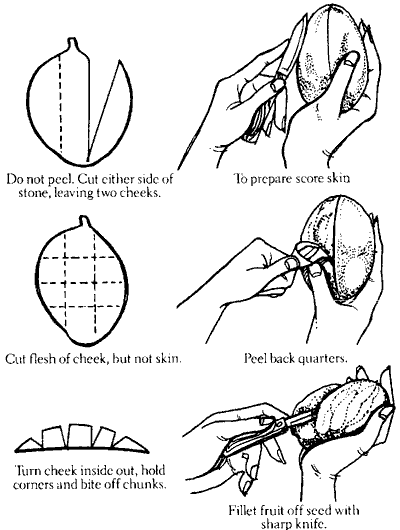
EATING MANGOS
SCIENTIFIC NAME: Mangifera indica
FAMILY: Anacardiaceae
The Editor received a very informative letter and advertising package from the Australian Marketers and Growers Corporation Pty. Ltd. of Victoria. It is so interesting, I have included all I can in the newsletter. The kit included a mango fork, pamphlets and recipes, a questionnaire and an information sheet.
Australian Marketers and Growers Corporation Pty. Ltd.,
25-27 Rathdowne Street, Carlton, VIC, 3053.
Dear Jacky,
I read with interest a copy of your Newsletter No.36 1/86 regarding Mango Forks (by Mrs. Brien Bosworth). I noticed you asked for more information at the foot of the article, so I have enclosed a copy of our 1985 Mango Retailer kits given to supermarket and retail outlets in Brisbane, Newcastle, Sydney, Melbourne, Hobart and Adelaide.
You will see in the kit we have included a mango fork and a questionnaire relating to its use. The forks were purchased by us in Mexico after a visit by one of our marketing people. We thought their design and use could be a novel way to improve mango consumption. Obviously, the Mexican forks are not made of sterling silver but, never the less, they were reasonably expensive after freight and a 25% import duty!! Perhaps we need to approach a local manufacturer as suggested by Mrs. Bosworth.
However, here lies the dilemma. Not one questionnaire was returned by retailers. Perhaps this is a reflection of a poor questionnaire or a belief by the retailers that it is not a produce accessory they wish to handle. I would suspect the latter, as the mango season is relatively short and carryover of stock in the form of mango forks would be a concern. I guess the commercial lesson is to tackle the consumer end of the market or simply give them away as a part of a major mango promotional campaign.
As you can see I don't have the answers but I do know where you can buy some mango forks. They aren't sterling silver!! But, they may be worth their weight in gold.
Yours sincerely,
R. K. Vennard.
NATURALLY FRESH (Australian Marketers and Growers Corporation Pty. Ltd.)
MANGO FORK - HOW TO USE
1. Push the longer prong of the fork as far as possible into the pit(seed) of the mango at the end where the stem has been cut.
2. The two small prongs are to stop the mango rotating while eating.
3. Peel the skin of the mango downward from the end where the fork has been inserted.
4. The mango can be eaten slicing the pulp with a knife or biting into the flesh of the mango.
HOW TO PEEL AND EAT MANGOES

MANGOES, the world's most popular fruit, have flourished in Australia since early settlement. The best mangoes are the BEAUMONT SPECIAL and SCARDALE from the premium Bowen area in Queensland.
Mangoes ripen from yellow green in a few days at room temperature. They are ready to eat when they yield to gentle pressure. Their outside colour should be golden yellow, flushed with a delicate pink-red tinge. They can be kept after ripening for several more days in a refrigerator.
Best of all, mangoes are a delicious fruit and also nutritious, providing vitamins A, C, B1 and B2 plus calcium, phosphorous and iron.
DATE: May 1986
* * * * * * * * * * * * *
